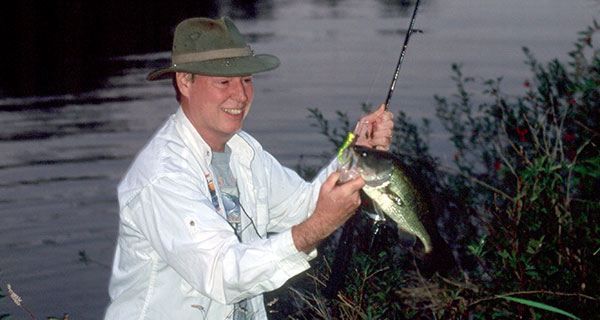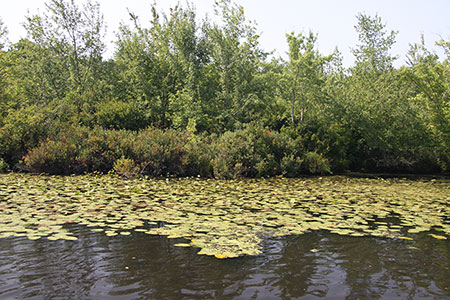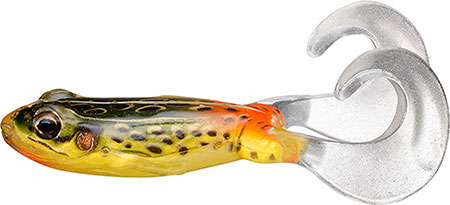
By Tom Schlichter
Any way you cut it, August is likely to be hot. That’s a plain and simple fact with which both freshwater anglers and their quarry have to make peace. From a predatory fish’s point of view, much of late summer will be spent finding shaded, cool water, locating ambush points well off the beaten track, and making the most of a few feeding opportunities each day. Local anglers need to focus on the same basic points if they hope to find success on a regular basis.
Flip through the national magazines and websites this month and you’ll likely find plenty of tips for targeting largemouth bass in deep, cool water. That’s all well and fine if you live near a big, deep lake but most of Long Island’s ponds are of the dishpan variety – shallow, weedy, circular and lacking any significant hard structure once you push off the bank. So, right out of the gate you can toss any ideas you might pick up about ripping big-lipped crank baits to dig down deep, split-shot worming, slow-rolling spinnerbaits across submerged stump fields or bouncing a Shad Rap or Rattletrap along some long-ago flooded road bed. It’s just not going to happen in our smallish ponds.
If that leaves you wondering what approaches are left to try, count yourself among the frazzled masses but don’t despair. By getting up close and personal with shoreline brush, shade lines and nearly impenetrable weed mats, it’s still possible to pull together a solid catch. You can start with a basic jig & pig approach, or work the shoreline and a few deeper holes with weedless worms and Senkos rigged wacky style. If those approaches fail to produce, however, you’ll need to get more up close and personal with shady, snaggy and off-the-beaten-track pockets others fear to tread. I cover these areas with two primary approaches – frogging the shoreline and pitching creature baits into serious tangles. Both techniques work best if you push back into areas less serious anglers avoid.
FROG THE SHORELINE

You’d be surprised just how close to the bank bigmouth bass will hold if there is a little shade overhead. In expansive waters like Swan Pond in Calverton, Forge Pond in Riverhead, Hidden Pond in Hither Hills State Park or even Belmont Lake in North Babylon, it’s possible to find long stretches where eight inches to a foot of water press right up against the bank or bulkhead. As shallow as this may seem, it can be prime bassin’ territory – especially if draped in an early morning or late afternoon shadow line.
With the bass in tight against the bank in such waters, a quiet approach is absolutely necessary as the slightest clang of an oar against a johnboat, heavy shuffling of feet, forceful paddling, careless motoring or even a lure landing with a loud “splat” as it enters the water can send these fish scurrying in all directions. That’s one reason I like to frog the shoreline. By tossing a weedless frog up on the bank or bulkhead – or as tight against the edge as possible – I can keep intrusive entries to a minimum while presenting a large profile to a big bass that might feel inclined to feed only once or twice a day through the heat of summer.
There are a variety of weedless frogs on the market today that are suitable for this kind of fishing. One of my favorites is a 2-3/8-inch Spro Bronzeye frog in albino, leopard or rainforest black. Snag Proof’s ½-ounce Pro Series Tournament Frog in Fire Tiger or Junebug patterns work well, too. With either choice, the key this time of year is to is to toss them up onto the shore along a grassy edge, several feet back into the phragmites or cattails, or right into the thick of leafy shoreline brush. Gently pull the frog into position at the water’s edge or wiggle it to the end of a branch suspended slightly above the water, and then allow it to hop or fall into the strike zone with a gentle splash. Let it sit for five seconds or so before providing a light twitch. Let it rest again for several more seconds, then pop or crank it home while holding on tight. Most strikes come on the first few cranks.
A HOT NEW ENTRY

One frog I’ve yet to try but that I’m sure I’m going to like is the new Free Style Frog by Live Target. It was introduced at the 2019 ICAST Show this July and really looks interesting.
Manufactured using a radically new process called Injected Core Technology (ITC), the Free Style Frog features an anatomically perfect replica of a frog body encapsulated in a soft-plastic exo-skin. With upright V-shaped legs, it has an especially tantalizing action to attract topwater predators. The exo-skin provides the action with two big floppy curl tails that are clear and which virtually vanish in the water so bass and other predators see a smaller, more exact profile while anglers still have plenty of casting weight plus lots of commotion on the retrieve. You can check out this new frog pattern at www.livetarget.com (https://livetargetlures.com/collections/new/products/freestyle-frog).
FIND ‘EM IN THE JUNGLE
The toughest tangles see the least pressure from anglers, so these areas are right where you’ll want to head if truly serious about hooking trophy bass during the late summer period. Quietly position your boat or kayak at the edge of an overhanging willow, oak, swamp maple or nasty-looking blow-down and hand pitch a big, pliable creature bait right into the mess. Try a Strike King KVD Rodent Bait, Yamamoto Creature Bait or Strike King Rage Smoking Rooster Bait for this – rigged weedless, of course.
Here, the idea is to almost fish straight up and down. You’ve got to come in silently, so fishing on windless days that allow superior boat control is a big help. When strong breezes make a quiet, controlled approach unlikely, get out and wade if water depths and a muddy bottom aren’t prohibitive. Approaching on foot allows calculating anglers to not only get in tight, but to push deeper up small channels and back into the tangles where boaters rarely venture. You’ll find some huge fish back in these areas. Swampy sections can be particularly productive but be sure to carry along some bug spray and watch for sink holes as you slowly advance.
You’ll want to try this prospecting with a heavy rod and 17- to 30-pound test line. Favor braided lines for their strength and thin diameter, but expect to lose plenty of lures, straighten a few hooks, and drop as many fish as you catch. The presentation key is to look for small pockets behind obvious tangles, and to envision how you will extract a striking lunker before ever presenting your lure.
Oftentimes, when hand pitching like this, I’ll strip several feet of line from my reel and close the bail or engage the gears before tossing my lure into a promising but snag-infested spot. Since many strikes come almost immediately as the lure hits the water, being ready to set the hook quickly provides a huge advantage. Fish a tight drag and swing on the slightest line twitch. Also, stand your ground as a lunker tries to power away because giving up line will only end in a break-off as your quarry weaves through submerged branches. If you aren’t losing both fish and tackle, you aren’t probing deep enough into the tangles.









